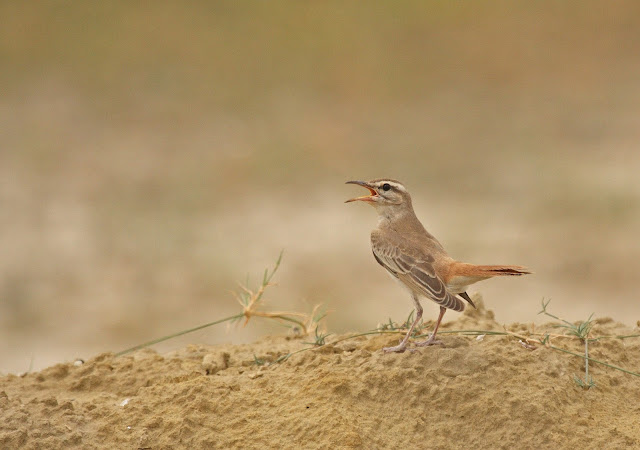Bird Calls: To play or not to play
Cut that
call: Ethics and Misuse of Artificial
Birdcalls
Thanks
are due to the team at Round Glass
A few years ago, I was in Nagaland working on a community
conservation project in the
Mokokchung-Zunheboto area. In addition to project work, other members of the team and I would
go on birdwatching walks at dawn, braving the early morning chill for sightings
of grey sibia and mountain bamboo partridge. On one of these walks, I remember one of my companions playing the call of
the Naga wren babbler (Spelaeornis chocolatinus) for so long that the
poor bird came and sat on the blessed phone.
When I asked him if this was wise, he argued that he was one of the more
serious bird watchers in the country, and could tell that the bird was not
disturbed. I asked what would happen if people from the surrounding landscape
(including those who hunt) picked up this practice, but he was confident that
they could not. The basis for this self-assurance remains unclear.
The incident left me distressed: The Naga
wren babbler is classified as “near threatened” on the IUCN Red List, has a
moderately small range, and may have a declining population as well. Surely,
this little species did not need any more difficulties. More importantly: Had we come so far only to
see the babbler sitting on a cellular phone?
A few weeks ago, the issue resurfaced when I was
asked if we play bird calls when we take students on birdwatching walks.
Perhaps this was more common a practice than I had realised. Intrigued, I
decided to dig deeper.
Rufous-tailed scrub robin
Image: Dharmendra Khandal
But before we delve into the ethics of artificial birdcall,
let us define what we are discussing. According to birder and author, Sumit
Sen, playing birdcall
“is achieved by playing back
pre-recorded calls, or recording a bird call in the field and playing it back.”
The goal is to draw the bird to a spot where it can be properly observed, and in
many cases, photographed. As birds cannot tell a fake call from a real one,
they often respond by approaching the source of the sound.
The consequences intensify during breeding season,
when artificial birdcall “could
distract adults from more important tasks like courtship, nest guarding, and
defending territories,” write Shekar Dattatri and Ramki Sreenivasan in “A
Guide to Ethical Wildlife Photography”. These actions impact the breeding success of the species, and raise questions about the very
purpose of birdwatching: Has the photograph become more important than
the bird itself?
This is a great point of contention in the wildlife
conservation community. Aasheesh Pittie, ornithologist and author of Intimacy without Violation, believes the
use of artificial birdcall is increasing. “Birders unabashedly ogle at the way birds live their lives —
irrespective of what they’re doing, and are insensitive to the effect this
behaviour might have upon them.”
It is a sentiment shared by Dr Paul Jepson in his article, “Bird
Playback – Reflections on Audio Technology and Birding Practices”. His cause for concern is based on a visit to a
popular birding spot in Arunachal Pradesh, “When I asked our guide when the best time to visit Eaglenest Wildlife
Sanctuary was, his response was, ‘In February, before the tapes have pushed the
birds away.”’
The use of birdcall is tempting, especially when
one has travelled halfway across the country in the hope of seeing a species. The
reality, however, is that it is banned in many protected areas. Repeated playback could negatively affect
the birds one is targeting, writes wildlife biologist and journalist Aathira
Perinchery, but adds that it “could be
used as a tool to study the functions of bird song and behaviour.”
Spotted creeper
Image: Dharmendra Khandal
This point of view raises even more questions.
There is no doubt that there is a need for self-regulation, but beyond that,
should we steer clear of playbacks entirely, or only in Protected Areas? Should
it be limited to use in scientific study alone? How does one draw the line, in
today’s age of democratised technology and citizen science, between a scientist
and a tourist? And where does this stop, given we now have scientists proposing
the use of artificial birdcall to get fruit-eating species to disperse seeds.
(This project is being conducted on the Hawaiian island of Oahu, and is currently in pilot-stage).
Today, unfortunately, the use of artificial
birdcall falls in the list of actions many of us justify using the line “So what, everyone does it”. This is especially
alarming when we consider the growing market of wildlife and ecotourism. An
increasing number of people from urban areas are seeking to leave the grime of their
cities behind, to find green spaces with clean air, lush hills, and wildlife to
spot around every corner, if only for a few days every few months.
It may not be too late to address the
issue. Policy and government-level changes are one aspect of this, but the
birding community can come together to prioritise birds over photographs, checklists,
and publications. To quote Aasheesh
Pittie again, “The cardinal rule of birding is that the bird comes first — not the good
view that a birder desires, not the correct ID, not the best photographic shot…if it is unidentifiable (in your
photograph), let the mystery remain, isn’t that part of birding too?”


Thanks ~
ReplyDelete